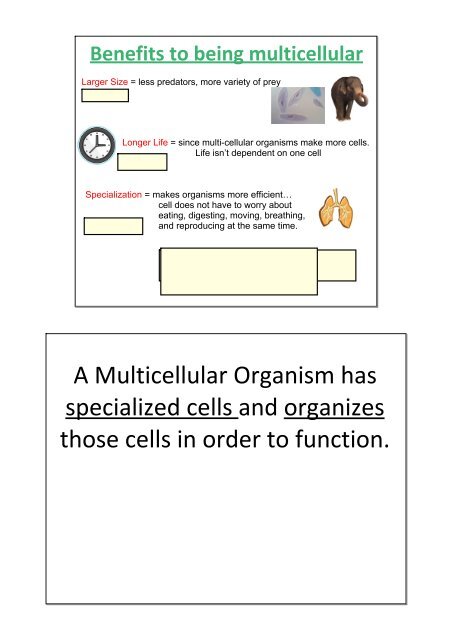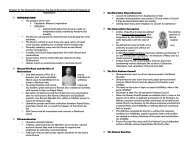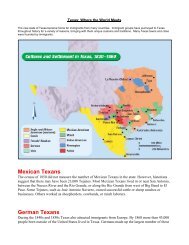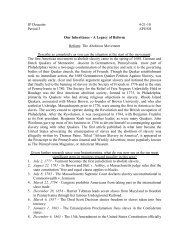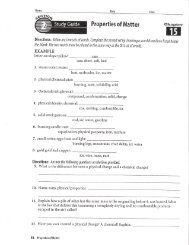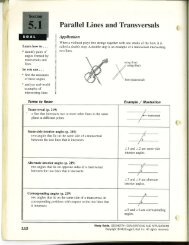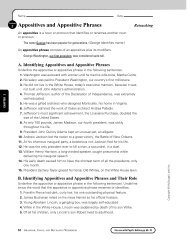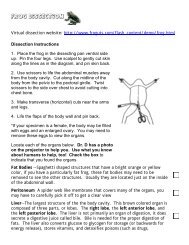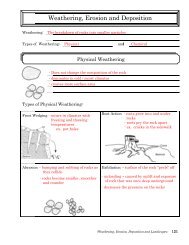A Multicellular Organism has specialized cells and ... - Teacher
A Multicellular Organism has specialized cells and ... - Teacher
A Multicellular Organism has specialized cells and ... - Teacher
Create successful ePaper yourself
Turn your PDF publications into a flip-book with our unique Google optimized e-Paper software.
Benefits to being multicellular<br />
Larger Size = less predators, more variety of prey<br />
Longer Life = since multicellular organisms make more <strong>cells</strong>.<br />
Life isn’t dependent on one cell<br />
Specialization = makes organisms more efficient…<br />
cell does not have to worry about<br />
eating, digesting, moving, breathing,<br />
<strong>and</strong> reproducing at the same time.<br />
A <strong>Multicellular</strong> <strong>Organism</strong> <strong>has</strong><br />
<strong>specialized</strong> <strong>cells</strong> <strong>and</strong> organizes<br />
those <strong>cells</strong> in order to function.
Objectives: Describe four levels of organization in living things
4 Basic Types of Animal Tissue:<br />
Connective, Protective, Nerve, Muscle<br />
http://www.bio.miami.edu/~cmallery/150/physiol/sf38x5.jpg
3 Types of Plant Tissue: Transport, Protective, Ground<br />
http://www.phschool.com/science/biology_place/biocoach/plants/tissue.html<br />
Structure- is the arrangement of parts in an<br />
organism<br />
What it looks like? Feels like?<br />
Descriptive Nouns<br />
Function- is the job the part does<br />
What action does it perform?<br />
Verb/Verb Phrase
Alveoli are small<br />
spongy sacs in<br />
the lungs.<br />
Structure-<br />
Function-<br />
Alveoli help put<br />
oxygen in blood<br />
<strong>and</strong> take carbon<br />
dioxide out.<br />
"Gas Exchange"<br />
Objectives: Explain why <strong>cells</strong> are small<br />
Now Lets Talk about Cell Size...<br />
Remember Elephant Sized Amoebas??<br />
1 cm<br />
6 cm 2 / 1 cm 3 = 6<br />
2 cm<br />
24 cm 2 / 8 cm 3 = 3<br />
3 cm<br />
54 cm 2 / 27 cm 3 = 2<br />
4 cm<br />
96 cm 2 / 64 cm 3 = 1.5<br />
5 cm 150 cm 2 / 125 cm 3 = 1.2
Objectives: Explain why <strong>cells</strong> are small<br />
Now Lets Talk about Cell Size...<br />
Remember Elephant Sized Amoebas??<br />
Why do Cells have to be small?<br />
If a cell's volume gets to large, the<br />
cell's surface area will not be able to<br />
take in enough nutrients or get rid of<br />
enough wastes fast enough to keep<br />
the cell alive.<br />
Multicellular organisms can be more complex<br />
because <strong>cells</strong> are <strong>specialized</strong>! Specialization allows<br />
some <strong>cells</strong> to do only 1 job. Therefore, the<br />
organism is more efficient. Multicellular organisms<br />
are larger which means they have fewer predators,<br />
so they most likely live longer. In addition if a<br />
unicellular organism's cell dies, the organism dies.<br />
If a multicellular organism's cell dies it does not<br />
mean the death of the organism.
1. Explain how the structure of the cell wall relates to its function.<br />
2. One of your classmates states that "All organisms must have<br />
organ systems". Is your classmates hypothesis true or false?<br />
Explain why or why not.<br />
3. The surface area-to-volume ratio of a cell limits _____.<br />
4. What questions do you have before the test? What would you<br />
like to review?


